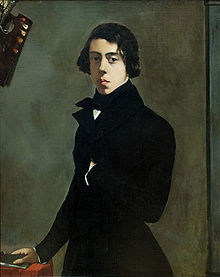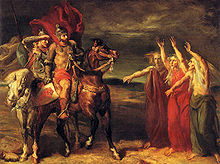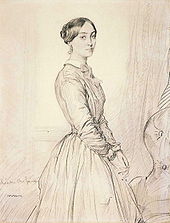- Théodore Chassériau
-
 Portrait of the Artist in a Redingote, 1835, oil on canvas, 99 x 82 cm, Paris, Louvre. A self-portrait of Chassériau painted at the age of 16.
Portrait of the Artist in a Redingote, 1835, oil on canvas, 99 x 82 cm, Paris, Louvre. A self-portrait of Chassériau painted at the age of 16.
Théodore Chassériau (September 20, 1819 – October 8, 1856) was a French romantic painter noted for his portraits, historical and religious paintings, allegorical murals, and Orientalist images inspired by his travels to Algeria.
Contents
Life and work
Chassériau was born in Samaná, in Saint Domingue (now the Dominican Republic). His father was a French adventurer who, at the time of Théodore's birth, held an administrative position in what was then a French colony; his mother was the daughter of a Creole landowner. The family moved to Paris in 1821, where the young Chassériau soon showed precocious drawing skill. He was accepted into the studio of Jean-Auguste-Dominique Ingres in 1830, at the age of eleven, becoming the favorite pupil of the great classicist, who came to regard him as his truest disciple.[1] (An account that may be apocryphal has Ingres declaring "Come, gentlemen, come see, this child will be the Napoleon of painting.")[2]
After Ingres left Paris in 1834 to become director of the French Academy in Rome, Chassériau fell under the influence of Eugène Delacroix, whose brand of painterly colorism was anathema to Ingres. Chassériau's art has often been characterized as an attempt to reconcile the classicism of Ingres with the romanticism of Delacroix. He first exhibited at the Paris Salon in 1836, and was awarded a third-place medal in the category of history painting.[3] In 1840 Chassériau travelled to Rome and met with Ingres, whose bitterness at the direction his student's work was taking led to a decisive break.
Among the chief works of his early maturity are Susanna and the Elders and Venus Anadyomene (both 1839), Diana Surprised by Actaeon (1840), Andromeda Chained to the Rock by the Nereids (1840), and The Toilette of Esther (1841), all of which reveal a very personal ideal in depicting the female nude.[4] Chassériau's major religious paintings from these years, Christ on the Mount of Olives (a subject he treated in 1840 and again in 1844) and The Descent from the Cross (1842), received mixed reviews from the critics; among the artist's champions was Théophile Gautier. Chassériau also carried out a commission for murals depicting the life of Saint Mary of Egypt in the Church of Saint-Merri in Paris; these were completed in 1843.
Portraits from this period include the Portrait of the Reverend Father Dominique Lacordaire, of the Order of the Predicant Friars (1840), and The Two Sisters (1843), which depicts Chassériau's sisters Adèle and Aline.
Throughout his life he was a prolific draftsman; his many portrait drawings executed with a finely pointed graphite pencil are close in style to those of Ingres. He also created a body of 29 prints, including a group of eighteen etchings of subjects from Shakespeare's "Othello" in 1844.[5]
In 1846, shortly after painting the colossal Ali-Ben-Hamet, Caliph of Constantine and Chief of the Haractas, Followed by his Escort, Chassériau made his first trip to Algeria. From sketches made on this and subsequent trips he painted such subjects as Arab Chiefs Visiting Their Vassals and Jewish Women on a Balcony (both 1849, now in the Louvre). A major late work, The Tepidarium (1853, in the Musée d'Orsay), depicts a large group of women drying themselves after bathing, in an architectural setting inspired by the artist's trip in 1840 to Pompeii. His most monumental work was his decoration of the grand staircase of the Cour des Comptes, commissioned by the state in 1844 and completed in 1848. This work was heavily damaged in May 1871 by a fire set during the Commune, and only fragments could be recovered; these are preserved in the Louvre.
After a period of ill health, exacerbated by his exhausting work on commissions for murals to decorate the Churches of Saint-Roch and Saint-Philippe-du-Roule, Chassériau died at the age of 37 in Paris, on October 8, 1856.
His work had a significant impact on the style of Puvis de Chavannes and Gustave Moreau, and—through those artists' influence—reverberations in the work of Paul Gauguin and Henri Matisse.[6] There is in Paris a Society for the painter: Association des Amis de Théodore Chassériau (see External links).
Selected works
- Self-portrait (Chassériau)
- Aline Chassériau
Gallery
-
The Two Sisters, 1843, oil on canvas, 180 x 135 cm, Paris, Louvre
Notes
References
- Fisher, Jay M.(1979). Théodore Chassériau: Illustrations for Othello. Baltimore: The Baltimore Museum of Art. ISBN 0-912298-50-2
- Guégan, Stéphane; Pomaréde, Vincent; Prat, Louis-Antoine (2002). Théodore Chassériau, 1819-1856: the unknown romantic. New Haven and London: Yale University Press. ISBN 1-58839-067-5
- Miller, Peter Benson (2004). "By the Sword and the Plow: Théodore Chassériau's Cour des Comptes Murals and Algeria," The Art Bulletin vol. 86, no. 4 (Dec. 2004), pp. 690–718.
External links
 Media related to Théodore Chassériau at Wikimedia Commons
Media related to Théodore Chassériau at Wikimedia Commons- expo Chasseriau
- Théodore Chassériau in Fine Art Critics
- insecula (Chasseriau)
- Association des amis de Chassériau
- Famille Chasseriau, Généalogie d'Haiti et de Saint-Domingue
- Portrait de femme
- Théodore Chassériau exhibition at the Metropolitan Museum of Art The Metropolitan Museum of Art, New York Retrieved on April 15, 2007.
Categories:- 1819 births
- 1856 deaths
- French romantic painters
- History artists
- Portrait artists
- Burials at Montmartre Cemetery
- Chassériau family
Wikimedia Foundation. 2010.






